Trout
They don’t have scales for their first month of life!
Advertisement
Trout Facts
- Prey
- Crayfish, minnows, insects
- Group Behavior
- School
- Fun Fact
- They don’t have scales for their first month of life!
- Estimated Population Size
- Unknown
- Biggest Threat
- Climate change
- Most Distinctive Feature
- Spotted dorsal fin
- Other Name(s)
- Steelhead
- Gestation Period
- 66-104 days
- Optimum pH Level
- 6.5 to 8
- Habitat
- Rivers, streams, lakes
- Predators
- Humans, bears, eagles
- Diet
- Carnivore
- Type
- Fish
- Common Name
- Trout
- Number Of Species
- 14
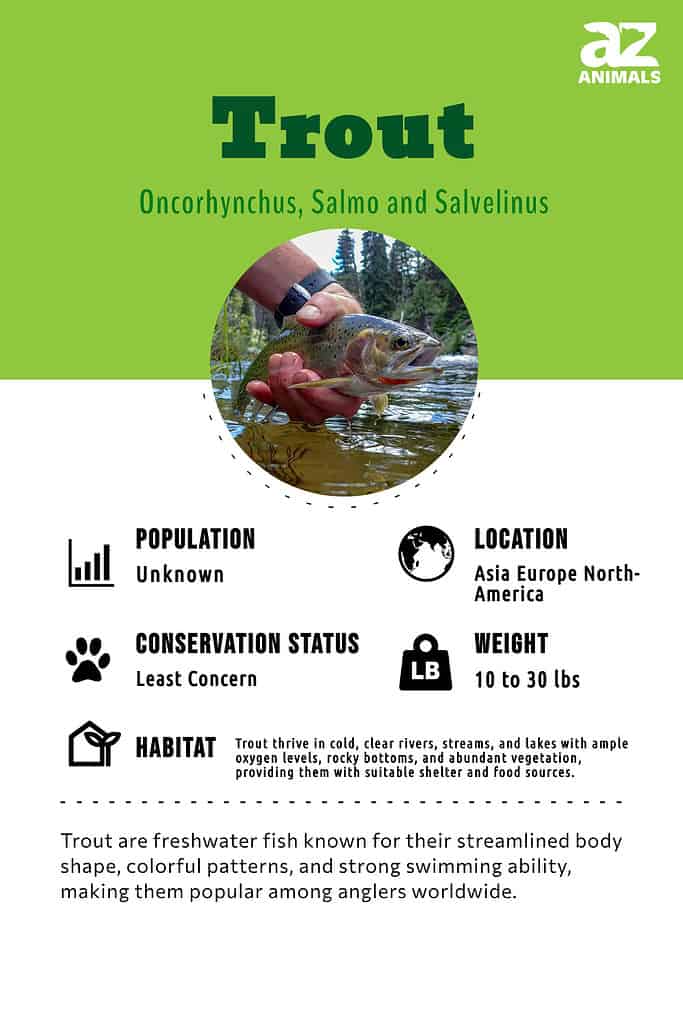
A trout is not a single species.
The name trout refers to a type of freshwater fish that lives in cold rivers and lakes all over the world. Trout are native to North America, Europe, and other parts of the world. Most trout species fall into one of three categories: freshwater, saltwater, and anadromous. Anadromous trout spend time in salt water, but they return to freshwater streams to spawn.
5 Intriguing Facts About Trout
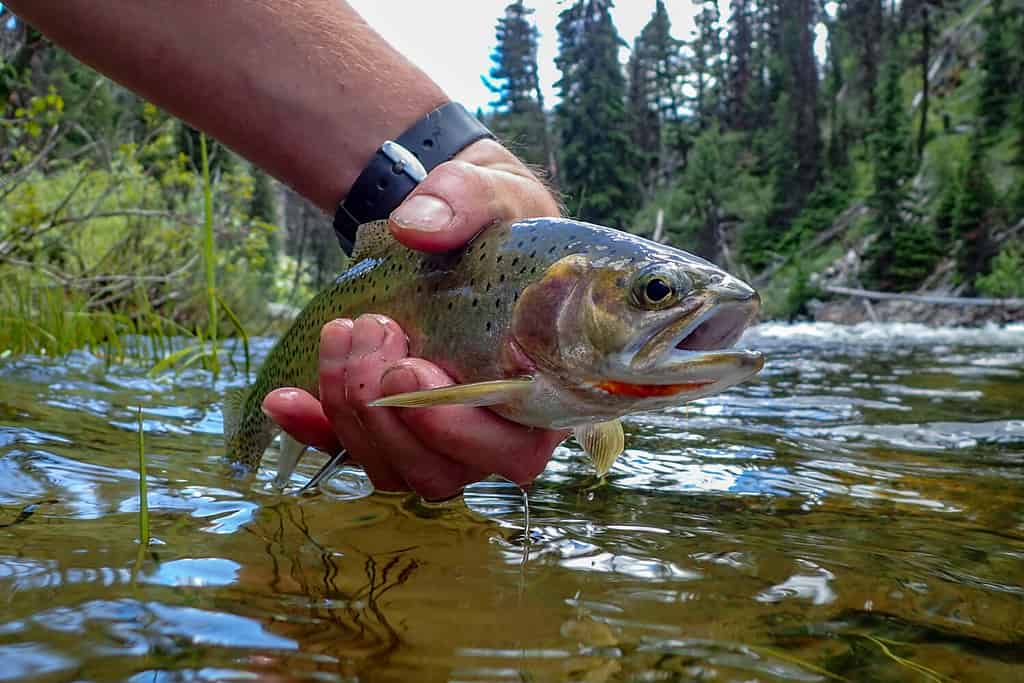
Trout is widely recognized as one of the most sought-after species among anglers worldwide.
©CSNafzger/Shutterstock.com
• Trout is one of the most popular game fish in the world.
• This fish thrives in cold, clean water.
• Trout don’t have scales in their first month of life.
• Trout that live in different places have different color patterns.
• Cooked trout is a delicious, nutrient-rich dish.
Classification and Scientific Name

Within the subfamily Salmonidae, the name “trout” is commonly employed to refer to certain species found in three out of the seven genera, namely Salmo, Oncorhynchus, or Salvelinus.
©K Steve Cope/Shutterstock.com
The name “trout” is commonly used for some species in three of the seven genera in the subfamily Salmonidae: Salmo, Oncorhynchus or Salvelinus. The Salvelinus genus also includes fish referred to as char or salmon. Some species that belong to the trout family include the following.
Salmo genus:
• Adriatic trout (Salmo obtusirostris)
• Brown trout (Salmo trutta)
• River trout (Salmo trutta morpha fario)
Oncorhynchus genus:
• Cutthroat trout (Oncorhynchus clarki)
• Colorado River cutthroat trout (O.c. pleuricius)
• Rainbow trout (Oncorhynchus mykiss)
Salvelinus genus:
• Brook trout (Salvelinus fontinalis)
• Dolly Valden trout (Salvelinus malma)
• Bull trout (Salvelinus confluentus)
Evolution and Origins
Rainbow trout are naturally found in the North Pacific Ocean and connected river systems extending from the Amur River in eastern Asia, stretching northward along the Pacific coast encompassing the Kamchatka Peninsula and northeastern regions of Russia, as well as along the Pacific coast of North America spanning from Alaska to northern Mexico.
Trout are naturally found across North America, northern Asia, and Europe, and were later introduced to Australia and New Zealand by recreational anglers during the 19th century.
This introduction had the unintended consequence of displacing and threatening various native fish species in upland areas.
Species
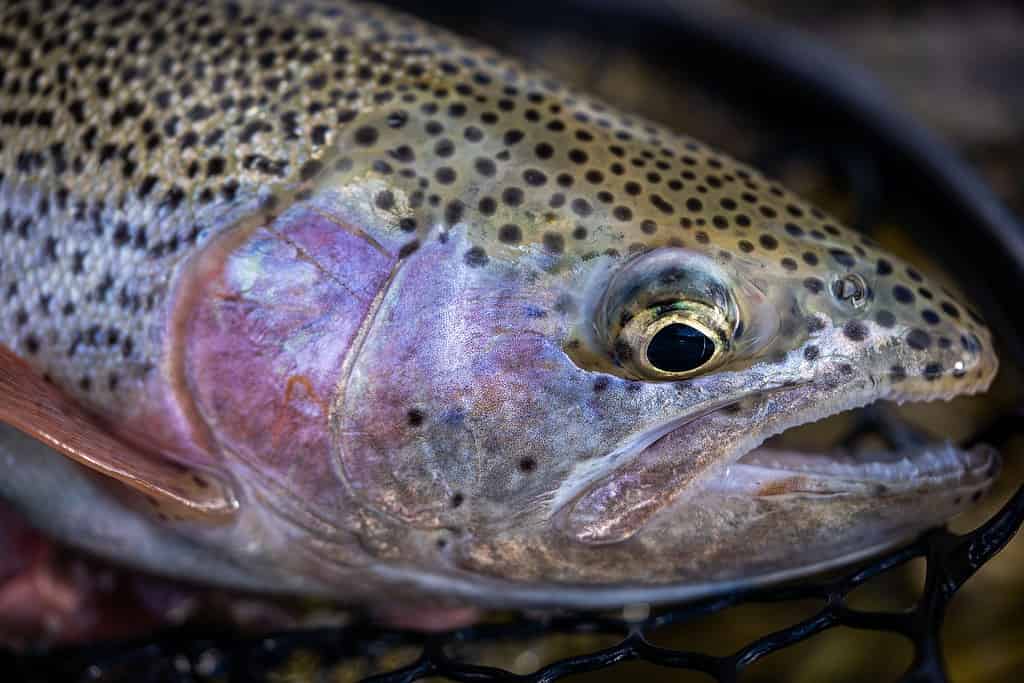
Trout comprises a total of 14 species, encompassing 13 freshwater species, including three hybrid variations, and one species adapted to saltwater environments.
©iStock.com/Wirestock
There are 14 species of trout. There are 13 species of freshwater trout, which includes three hybrid species, and one saltwater species.
The 9 species native to North America are:
• Brook
• Bull
• Dolly Varden
• Cutthroat
• Gila
• Brown
• Lake
• Apache
• Golden
• Rainbow
The 3 hybrid trout species are:
• Palomino (also known as the golden rainbow)
• Tiger
• Splake
Are you wondering about the brown trout? It is not native to North America. It is native to Asia and Europe, and it was introduced to North America in the 1800s.
Knowing what fish you’re talking about can be a little confusing when you talk about a fish this widespread and popular. For instance, brook trout is a recognized species in the U.S., but it is also another name for the European trout, which is native to the U.K. In parts of the U.S., brook trout are known as specked mud trout.
The steelhead trout (Onchorynkus mykiss) is sometimes confused with the rainbow trout. They are not the same fish, but a steelhead is an anadromous form of the coastal rainbow trout (o.m. irideus) or the Columbia River red band trout (o.m. gairdneri). Steelhead trout usually have thinner bodies and more silver coloring than freshwater rainbow trout.
Appearance
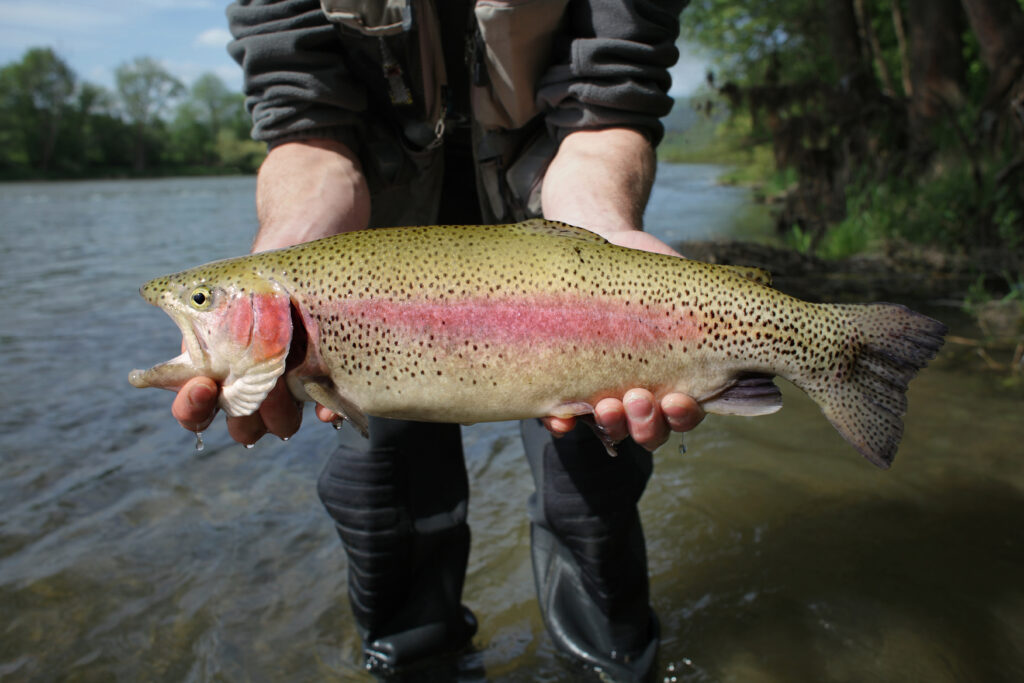
Trout, being a sizable fish, exhibits a range of colorations influenced by its habitat and specific trout species.
©pictoplay/Shutterstock.com
A trout is a large fish whose colors can vary depending on where it lives and what type of trout it is. It has a long, oval body, a small head, small eyes, and a mouth that stretches back across its body. Its most distinctive feature is a dorsal fin with iridescent spotting in various colors. It is usually dark with silvery-gray scales on its sides.
On average, trout can reach 2 feet in length, but their size varies by species. Anadromous species are usually larger than freshwater species.
Their colors also vary according to species and location. Freshwater rainbow trout, for instance, are known for their bright pink and purple colors, while steelhead trout are almost solid silver. Brown trout get their name from their spotted sides, and tiger trout have dark, distinctive stripes.
Distribution, Population, and Habitat
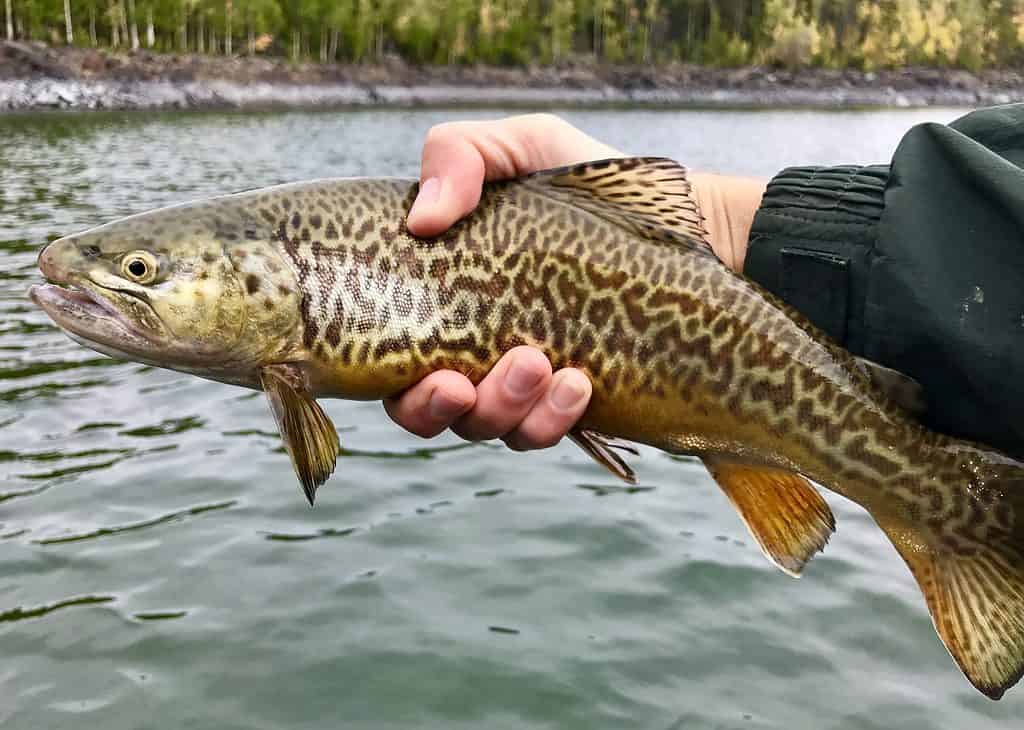
Trout thrive in cool freshwater environments, such as lakes, rivers, and streams, with their optimal temperature range being between 50 and 60 degrees Fahrenheit.
©Matt Jeppson/Shutterstock.com
Trout prefer cold lakes, rivers, and streams. Their ideal temperature is 50 to 60 degrees Fahrenheit. They are among the most common fish in northern wilderness areas. Freshwater species may spend their entire lives in the streams or rivers where they were born. Others are migratory. They travel to the ocean, spend time there, and then return to the place of their birth to reproduce. The exact population number is unknown, but most populations are considered stable.
Predators and Prey
Trout are an important food source for humans and animals. Some carnivores that eat trout include bears, eagles, otters, sawbill ducks, and larger fish like pike.
Trout are carnivores who feed on a wide variety of fish and aquatic animals. They will even eat mice and voles that fall into the water. Their diet includes:
• Crayfish
• Minnows
• Flies
• Mollusks
• Smaller fish
• Shrimp
• Dragonflies
• Worms
• Snails
• Grasshoppers
Reproduction and Lifespan
Male trout reach sexual maturity at two years old, and females reach it at three years. Males attract females by changing their scale colors to bright pink or red.
Trout Nest or Redd
They reproduce by spawning. The female first builds a nest by scooping out dirt and sediment to create a nesting area called a redd. Normally, she chooses a river bottom that has some gravel and sand. She deposits her eggs in the nest, and the male releases his sperm on top of the eggs. A trout can lay 200 to 8,000 eggs in a single spawning.
After 4 to 10 weeks, the eggs hatch. Many baby trout won’t survive. Most trout in the wild die before their first birthday.
Male trout can become aggressive when fighting over females and when defending their redds.
Fishing and Cooking
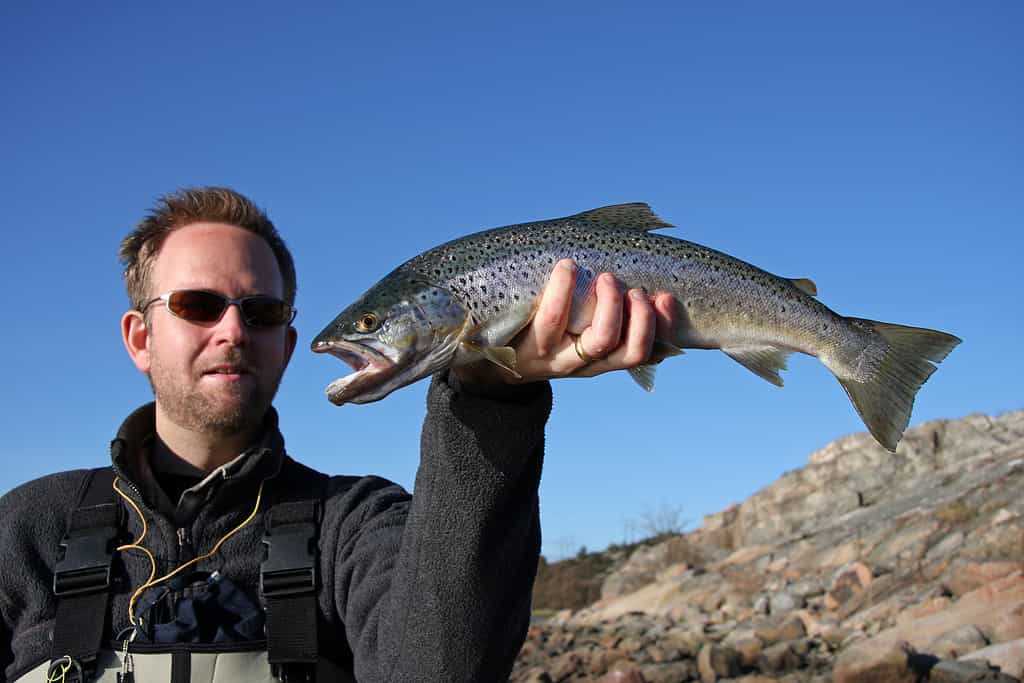
Trout is a beloved choice among seafood enthusiasts when it comes to cooked dishes. Despite its tendency to contain bones, trout is widely regarded as a delicious culinary option by most individuals.
©iStock.com/wcpmedia
Cooked trout is a favorite among people who like seafood. Although trout tends to be bony, most people find it delicious. The meat changes from pink to white once it’s cooked. It is extremely tender with a delicate flavor. It is easy to cut and file.
There are endless ways to cook trout, including grilling, smoking, baking, and pan-frying. Most culinary experts say a simple recipe makes the best-cooked trout. This allows the trout’s natural flavor to shine. Simple seasoning and grilling are all you need to make a spectacular trout filet. Any recipe that calls for salmon will work with trout.
Trout is classed as an “oily” fish, which means it is high in omega-3 fatty acids. The American Heart Association and other nutrition experts recommend eating oily fish for their nutrients and fatty acids. Trout is low in calories and fat.
They are also popular as game fish. Trout fishing is second only to bass fishing as the most popular type of fishing. The technique of fly fishing was developed specifically to catch trout in rivers. People who like ice fishing frequently hope to catch trout. In winter, trout stay close to the water surface looking for food, and this makes it easier to catch them. Rainbow and brown trout are the most common targets of ice fishing.
Trout tickling is an ancient way of catching these fish that doesn’t involve a rod, reel, or net. It involves stroking the trout until it falls into a trance. In Scotland, it’s called guddling. Trout tickling is illegal in most countries because it’s usually associated with poaching.
Population
Trout is listed as least concern by the IUCN Redlist and the International Union for the Conservation of Nature. As a popular game fish, trout populations are regularly restocked by fishery departments in countries all over the world. In recent years, however, conservationists have expressed concern about the fate of trout and other fish.
Climate change has a direct impact on the cold temperatures these fish need to thrive. Wildlife biologists in some areas are concerned about the population losses of trout native to those regions. Habitat loss, water pollution, and rising temperatures have affected trout populations.
Wild and Cold
Trout are among the most sought-after and beloved fish among fishers who enjoy the challenge of catching them. Immortalized in books and movies about fishing, they are symbols of the wild, cold wilderness.
View all 133 animals that start with TTrout FAQs (Frequently Asked Questions)
Is trout the same as salmon?
No, trout is not the same as salmon. They are different fish. They are related, however. Trout are closely related to salmon and char. Species termed salmon and char occur in the same genera that trout are in. They can breed with each other.
How can you tell them apart? Trout have teeth on the roofs of their mouths. They’re called vomerine teeth, and salmon don’t have them.
What does trout taste like?
Trout is famous as a fish that’s delicious when cooked. It has a delicate flavor that is not overly fishy. While the filet is particularly good, all parts of the fish are good to eat.
Do trout become salmon?
No, trout do not become salmon. These two types of fish share some similarities. They have a similar shape and size, and they travel upstream to spawn. Although they are not the same species, they can breed with each other to produce hybrid species.
How big do trout get?
Trout can get large. The largest trout caught on record was a 41-pound brown trout that was caught in Michigan in 2009. A 31-pound wild brown trout was caught in Scotland.
Where do trout live?
They mostly live in freshwater streams, rivers, lakes, and ponds. They thrive in cold, clean water.
Thank you for reading! Have some feedback for us? Contact the AZ Animals editorial team.
Sources
- Wild Trout Trust: Trout Facts, Available here: https://www.wildtrout.org/trout-facts#:~
- U.S. Fish and Wildlife Service: Brook Trout, Available here: https://www.fws.gov/southeast/wildlife/fishes/brook-trout/
- U.S. Fish and Wildlife Service: Steelhead Trout., Available here: https://fws.gov/fisheries/freshwater-fish-of-america/steelhead_trout.html

















